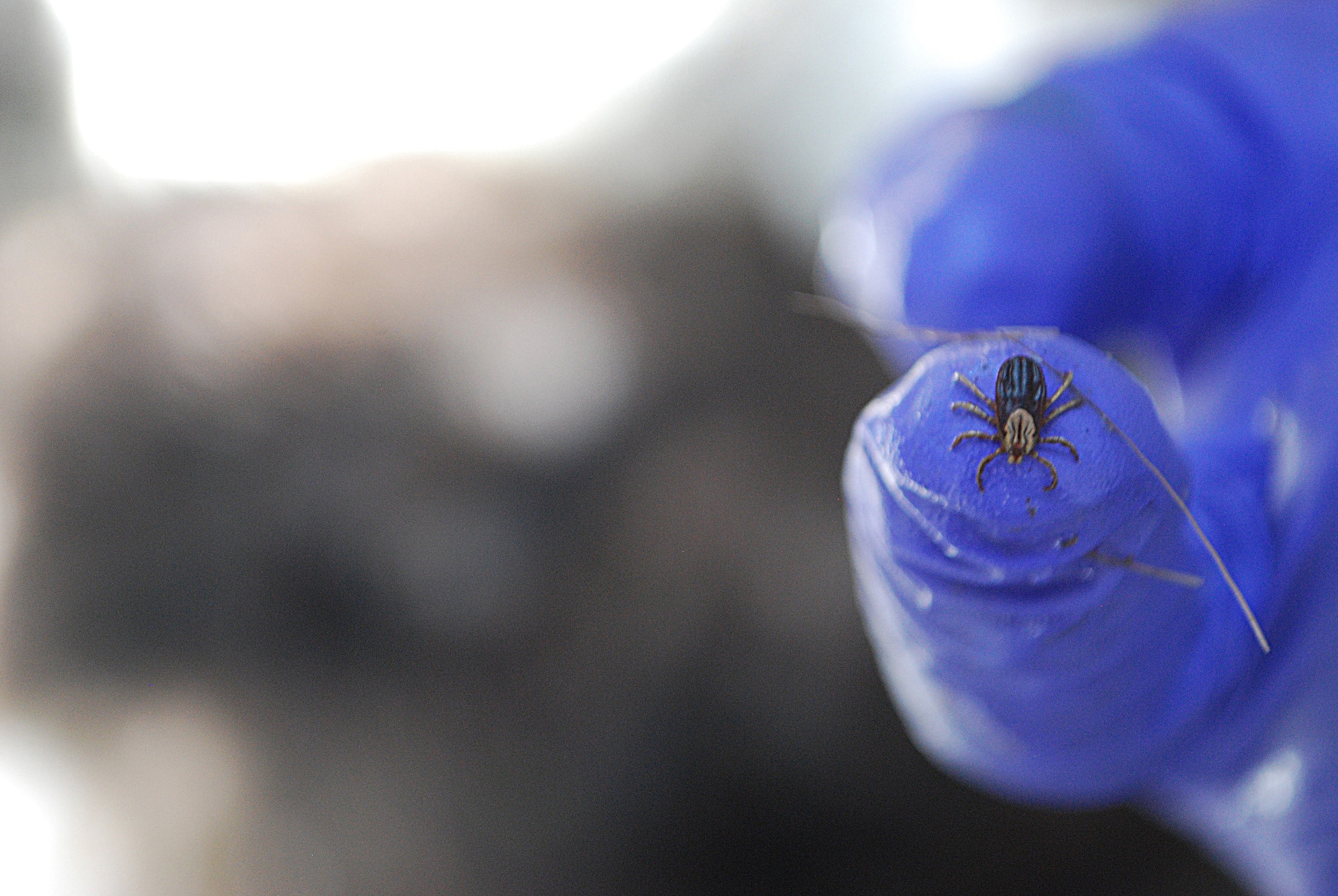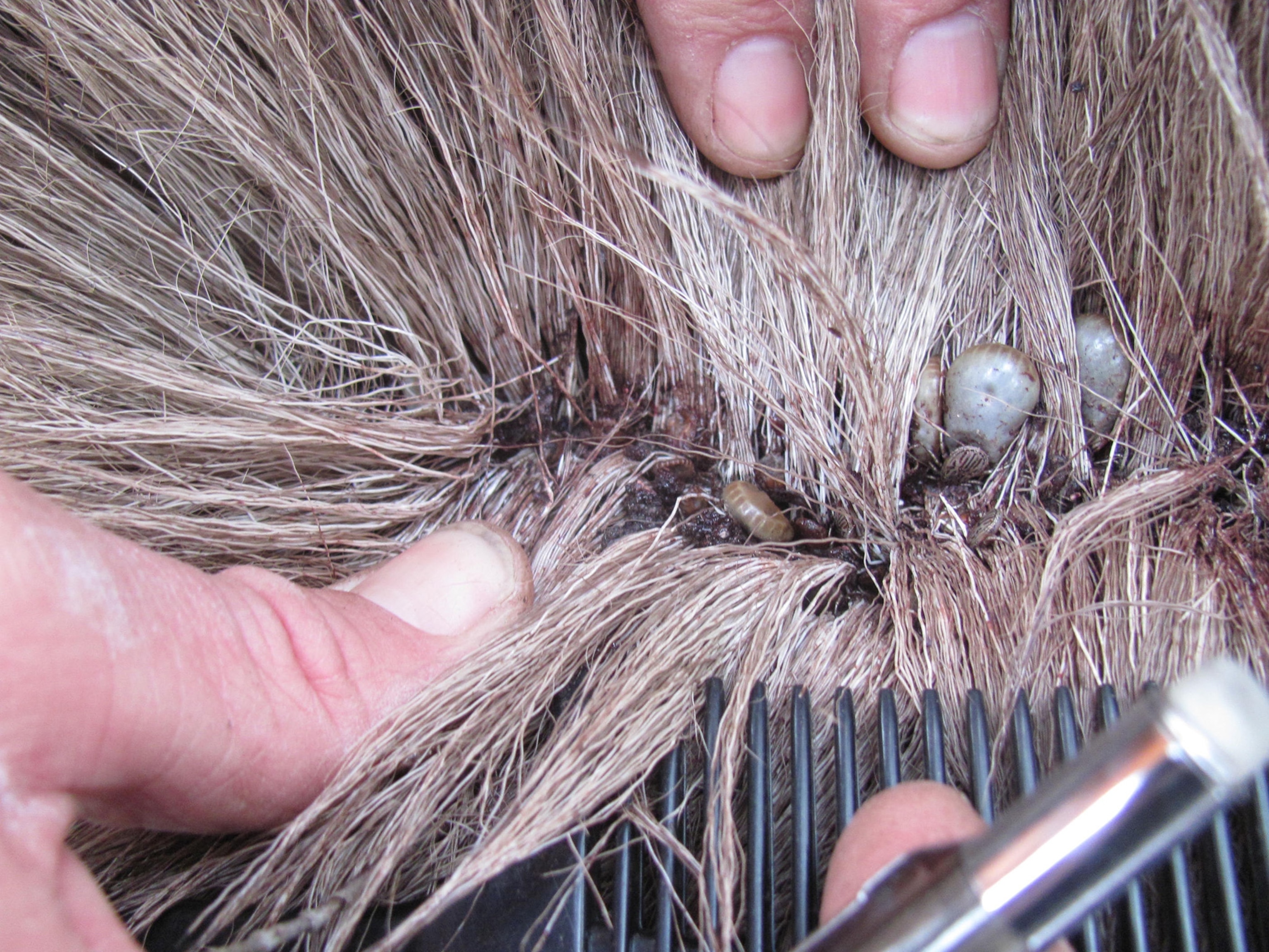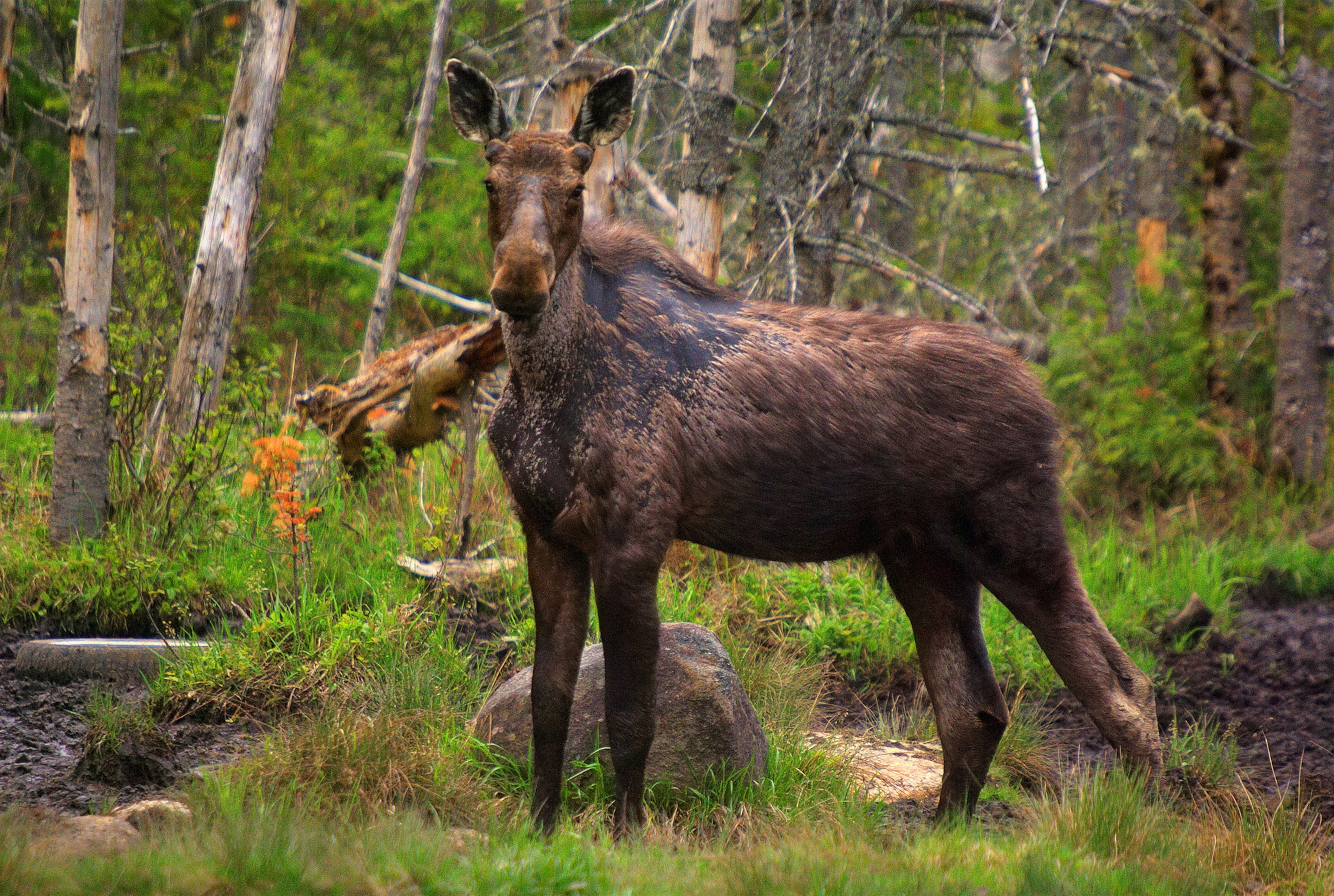
What's a Ghost Moose? How Ticks Are Killing an Iconic Animal
As New England winters get warmer and shorter, ticks are driving a worrisome decline in a species that's crucial to the region's economy.
EAST MOXIE TOWNSHIP, Maine—Lee Kantar crouches over a dead moose calf and pulls a clump of hair from its straggly shoulder.
A few days earlier, the sickly ten-month-old animal had waded through deep snow to this sun-dappled stand of spruce trees in western Maine, laid down, and died.
"See how white those hairs are?" says Kantar, a moose biologist for the state.
It's a telltale sign that the calf was becoming a "ghost moose"—an animal so irritated by ticks that it rubs off most of its dark brown hair, exposing its pale undercoat and bare skin.
With their skinny necks, emaciated bodies, and big, hairless splotches, these moose look like the walking dead as they stumble through the forest.
And in recent years in New England, ghost moose sightings have become increasingly familiar.
The reason is likely climate change, biologists say, which is ushering in shorter, warmer winters that are boosting the fortunes of winter ticks. The tiny creatures latch on to moose here in staggering numbers: One moose can house 75,000 ticks, which are helping to drive a troubling rise in moose deaths, especially among calves. (See "New Climate Change Report Warns of Dire Consequences.")
Mostly wiped out in New England by hunting in the 1800s, moose populations had begun rebounding in the late 1970s, thanks to a suddenly abundant food source—new spruce-fir forests that took root following a pest outbreak that wiped out much of the former forest.
By the late 1990s, about 7,500 moose were living in New Hampshire. But in 2013, the population there had dropped to 4,500. In vastly bigger Maine, which has about 60,000 moose—the densest population in the lower 48 states—there's a suspected decline, but there's less data.
It's unlikely that these leggy deer will disappear entirely from New England, but the surge in moose deaths has made investigating the causes a top priority for the region's scientists.
Though winter tick is the main culprit, scientists are trying to unravel the bigger mystery of what else is contributing to the deaths. Moose are highly susceptible to several kinds of parasites, and it's likely that many factors are at play.

Bill Samuel, a retired biologist and ghost moose expert at the University of Alberta in Canada, says that pinpointing a single reason for the deaths is "wishful thinking."
Scientists aren't the only ones concerned. Government agencies are also worried that the die-off could harm the tourism industry. They're funding a multiyear project to research what's going on with the animal, which graces Maine's state flag.
Wildlife watching, including moose viewing, contributed nearly $800 million to Maine's economy in 2011—the latest figure available—an increase of 82 percent since 2001, according to a report by the U.S. Fish and Wildlife Service and the U.S. Census Bureau. That's compared with $203 million spent on hunting in the same year.
In New Hampshire, hunters spent $61 million, while wildlife watchers spent $281 million.
"People come to Maine, they want to eat lobster," says Kantar, "but they want to see moose."

"The Month of Death"
Spring connotes rebirth, but to New England's moose scientists, April has become "the month of death." That's when calves, skinny and malnourished from the lean winter and exhausted from carrying thousands of ticks for five months, are most likely to drop dead. (Read how moose can get so big eating plants.)
The tick's life cycle begins in November, when larval ticks climb on plants, waiting for the six-foot-tall (two meter) moose to brush past. The ticks clamber aboard and feast on warm moose bodies until early spring, when they drop off their host.
In the past, after long New England winters that lasted well into April, the ticks would jump off moose, hit spring snow, and die, says Kristine Rines, moose project leader for New Hampshire Fish and Game.
But warmer, shorter winters means those ticks are more likely to land on bare, snowless ground, which lets them live another day—and possibly flourish.
Since 1970, average annual maximum temperatures in New Hampshire have warmed 0.5 to 2.1 degrees Fahrenheit—with the greatest warming occurring during the fall and winter, according to a 2014 report. Maine's warm season—defined as when the daily temperature is above freezing—has increased by two weeks from the early 1900s to the 2000s and is expected only to grow, says a 2015 report.
Rines was among the first to notice the emergence of tick-infested ghost moose in New England in the late 1990s. Ghost moose have long existed in other parts of North America, including southern Canada.
Two years ago, Rines, Kantar—deer and moose project leader for the Maine Department of Inland Fisheries and Wildlife—and their colleagues launched the project to collar moose mothers and their calves each spring and study those that die.
In 2014, the winter tick outbreak was so bad that more than half of the 22 collared moose calves in New Hampshire died. In Maine, 22 of 30 calves collared that year died, as well as ten adults, which are usually hardier than young animals. (Get more moose facts.)
This year is no better. In Maine, 21 of the 35 moose calves collared by scientists are dead. In New Hampshire, all but 7 of the 27 moose calves collared are dead.
So far, all but one of the dead moose studied in New Hampshire and Maine have been infested with ticks. Many also suffered from anemia due to blood loss.
Still, "it's a little surprising to a lot of folks—how can a tick kill a moose?" says Kantar.

One Unhealthy Animal
The latest casualty is known as 152, the female calf near East Moxie.
When she died, her GPS collar sent a signal to Kantar and team, biologists Scott McLellan and Matt O'Neal, so they could track down and dissect her remains.
For the scientists, who've been working around the clock, it's a familiar routine: 152 is the sixth moose calf to die in four days.
To get to her, Kantar and his team drive an hour from Bangor to a tract of private forest.
Then they hop on snowmobiles for a ride through a quiet forest of tall evergreens and hardwoods, their branches bare despite the onset of spring. When the trail gets too narrow, the scientists unload their gear (including "Cyndi Lauper," a nickname for their loppers, a type of shears used to crack moose ribs) and don snowshoes to walk the last 800 feet (240 meters) through the woods. It's easy to fall through the waist-deep snow to the uneven ground beneath—and extremely difficult to pull out of the hole without help.
When they finally reach the carcass, the three scientists jump into action. They set up a tree-supported pulley to weigh the body—342 pounds (155 kilograms), relatively skinny for a calf—and begin the bloody process of harvesting her body parts for further testing.
McLellan drops samples of spleen, pancreas, ovaries, and other organs into plastic jars. "Just another day in the office," he says.
Before long, it's clear that 152—the number is taken from her collar's GPS frequency—was one unhealthy animal. Engorged, blueberry-size ticks crawl on her corpse, and the scientists remove abnormally large lymph nodes, splotchy lungs, and a mottled liver. Slicing open her femur, the team find what they call "raspberry jam"—bright-red mucus where there should be healthy white fat.
The ticks had taken so much blood that her starving body was raiding its bone marrow, muscles, and even heart for precious protein. The moose, for all intents and purposes, was eating itself alive.

"Wishful Thinking"
The next morning, at a diagnostic laboratory at the University of Maine in Orono, Anne Lichtenwalner peers through her safety glasses at 152's sickly lung. "That's severe," says the director of the university's Animal Health Laboratory.
The lung, which should be a consistent pink, is instead various hues of red—the checkerboard pattern of lungworm, a common parasite in Maine moose that restricts air movement in the lung.
Lichtenwalner has found that up to 80 percent of the moose calves that come through her lab have such abnormal lung tissue. Often, she discovers big masses of lungworm in the animal's trachea that were trying to leave the dead body "like rats fleeing a ship."
Slicing a silver blade through the tissue, she notices a spaghetti-like lungworm next to a dead tick. "There you go—we've got winter tick and we've got lungworm—that's our problem here in Maine."
Lichtenwalner believes the story of the moose decline is more complicated than just ticks. In addition to lungworm, she says other stressors such as poor nutrition may work together to break down a moose's immunity: "When you're already getting sick with something, you're prone to getting more sick—your natural defenses might be lowered."
Samuel, the retired University of Alberta scientist, agrees. He says that most North American moose are struggling, and "not everyone" believes "that winter ticks are the primary problem."
"The reality appears to be that there are many factors working on moose," says Samuel, the author of White as a Ghost: Winter Ticks & Moose—parasites, availability of habitat, unregulated harvests, climate change, and more.
Climate change is encouraging the growth of another species: White-tailed deer.
Deer populations have increased in New England due to warmer winters, and where their numbers exceed 10 to 13 animals per square mile (2.6 square kilometers)—now most of New Hampshire—there's increased incidence of brain worm in moose, Rines says. (Also see "7 Species Hit Hard by Climate Change—Including One That's Already Extinct.")
"Deer and moose just aren't going to co-exist very well," she says in her truck, a moose bobblehead bouncing on the dashboard as she drives through her northern New Hampshire study site.

Moose Sighting
In the little New Hampshire town of Gorham, near where Rines and colleagues' collared moose roam, the public's love for the animal is hard to ignore.
A tourist can buy moose soap at a moose-themed gift shop, take a moose tour (chances of seeing one: 97.3 percent, the company says), or listen to a radio station called 92 Moose.
Even so, in springtime, when moose are less mobile, it can be challenging to see the real thing in the flesh.
But it's still worth a shot.
On an April evening, University of New Hampshire graduate student Henry Jones, who works with Rines, drives to 13-Mile Woods, a forest known for its salt licks—swampy spots where moose congregate to lick road salt.
Driving north, the Androscoggin River widened on the right, the landscape becoming wilder and more remote. Every so often he passes a road sign: "Brake for moose, it could save your life." At the first salt lick, Jones slows his truck—no moose, just some white-tailed deer.
He keeps driving.
Suddenly, something moves in the twilight: An adult female moose, fording the river. Within seconds, she charges through the swift currents and scrambles up the opposite bank into the forest. She turns back briefly, her gangly profile barely visible as she moves behind the trees, fading away like a ghost.








